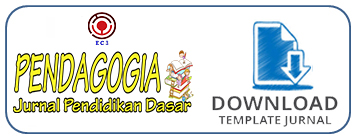Implementasi Pengelompokan Kelas Berdasarkan Kemampuan Akademik di MI Mambaul Ma’arif Denanyar Jombang
Keywords:
Class grouping, students, learningAbstract
Class grouping in educational institutions, especially in elementary schools, has been discussed for a long time, but is still relevant to the current educational context. Class grouping strategies have been studied by several educational researchers because of their considerable benefits for teachers and students. This study aims to determine the implementation of class grouping at MI Mambaul Ma'arif Denanyar Jombang, the purpose of class grouping, and the impact that arises from class grouping. This type of research is a quantitative descriptive research with data collection techniques through observation, interviews, and documentation. The results obtained in this study are the implementation of class grouping at MI Mambaul Ma'arif Denanyar Jombang based on students' academic abilities. In determining the grouping of madrasa students using measuring tools in the form of tests and a ranking system. The purpose of class grouping at MI Mambaul Ma'arif is to facilitate teachers in planning, implementing and assessing learning. In its application, it also has a positive impact, including optimizing student understanding and making it easier for teachers to deliver material. And the negative impact is, a negative view of classes that have low academic abilities. Therefore, to minimize this negative impact, madrasas apply the naming of each class using the names of dzuriyah pondok and the names of wali songo.
Downloads
References
Adodo. S.O & Agbaweya, J.O. (2011). Effect of homogenous and heterogenous ability grouping class teaching on student’s interest, attitude and achievement in integrated science. International Journal of Psychology and Counseling, 3(3), 48-57.
Ainurrahman. (2013). Belajar dan pembelajaran. (Bandung: Alfabeta).
Arifin, H.M, (2006). Filsafat Pendidikan Islam. Jakarta: Bumi Aksara.
Hendro Wibowo, Dody. (2015). Penerapan Pengelompokan Siswa Berdasarkan Prestasi Di Jenjang Sekolah Dasar. Jurnal Psikologi Undip, Vol. 14 No. 2, 148-159.
Hnushek, E.A., & Wobmann, L. (2006) Does Educational Tracking Effect Performance And Inequality. The Economy Journal
Hornby G., Witte C., & Mitchell D. (2011). Policies and practices of ability grouping in new Zealand intermediatw scholls. Support for learning
Huda, M. (2012). Cooperative Learning, Metode, Teknik, Struktur dan Model Terapan. Yogyakarta : Pustaka Pelajar.
Idi, Abdullah. (2014). Sosiologi Pendidikan. Jakarta: Rajawali Press.
Imron, A. (2012). Manajemen Peserta Didik Berbasis Sekolah. Jakarta : Bumi Aksara.
Kulik, J. A., & Kulik, C,-L. C. (1987) Effect Of Ability Grouping Of Student Achievement. Equity & Excellence In Education
Prihatin, E. (2011). Manajemen Peserta Didik. Bandung : Alfabeta.
Republik Indonesia, Undang-Undang Republik Indonesia No 20 Tahun 2003 Tentang Sistem Pendidikan Nasional.
Republik Indonesia. Undang-Undang. No. 20 Tahun 2003 Pasal 1 Ayat 1.
Slavin, R.E. (1990) Achievement Effects Of Ability Grouping In Secondary Scholl: A Best-Evidence Sythensis. Review Of Education Research .
Tim Dosen Administrasi Pendidikan Universitas Pendidikan Indonesia. (2008). Manajemen Pendidikan. Bandung : Alfabeta.
Downloads
Published
Issue
Section
License
Copyright (c) 2022 Eko Wahyu Dyah, Umi Hanifatus Sholihah, Nurul Fitriyah, Chaerati Saleh

This work is licensed under a Creative Commons Attribution-NonCommercial-ShareAlike 4.0 International License.








